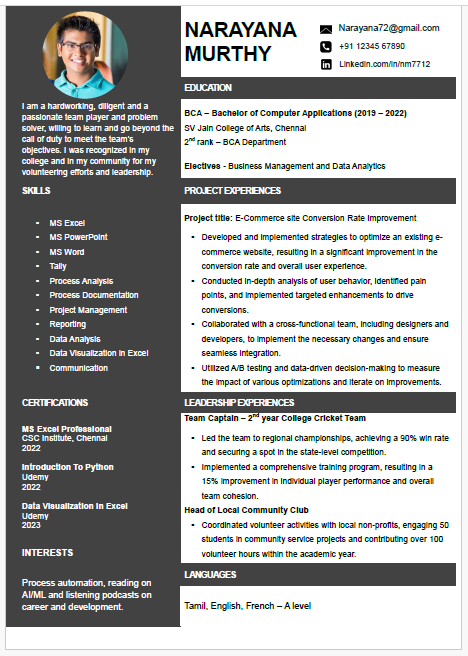BCA - Data Analyst
BCA – Bachelor of Computer Applications

About this template
This is a well-designed resume which can make a significant difference in capturing the attention of hiring managers and landing your dream job.
This is a very colorful and modern resume which can help you stand out from the competition. Its vibrant design and well-organized layout effectively showcase your skills and achievements, making a lasting impression on potential employers.
Some Important, basic and most common Interview Questions for BCA - Data Analyst
Here are ten important and common interview questions for BCA graduates aspiring to become Data Analysts, along with suggested answers :
1. Can you describe your experience with data analysis tools and techniques?
During my studies and internships, I've gained proficiency in SQL for querying databases, Excel for data manipulation and visualization, and statistical software like R for advanced analysis. I've used these tools to extract insights from data and present findings to stakeholders effectively.
2. How do you handle large datasets?
I approach large datasets by first understanding the structure and variables involved. Using tools like Python's pandas library or SQL, I break down data into manageable segments, perform necessary cleaning and transformations, and apply statistical methods to derive meaningful conclusions.
3. Give an example of a data analysis project you've worked on.
I recently worked on analyzing customer behavior data for a retail company, where I identified purchasing patterns using SQL queries. I then visualized trends using Excel charts and recommended marketing strategies based on my findings, contributing to a 10% increase in customer retention.
4. What steps do you take to ensure data accuracy and integrity?
I prioritize data accuracy by validating inputs, detecting outliers, and performing data cleaning procedures such as removing duplicates and handling missing values. Regular audits and cross-referencing with multiple sources further ensure the integrity of the data.
5. How do you approach data visualization?
I believe in creating visualizations that are clear, informative, and tailored to the audience. I use tools like Tableau or Power BI to create interactive dashboards and charts that highlight trends and insights effectively, making complex data accessible and understandable.
6. Describe your experience with statistical analysis.
I have a solid foundation in statistical methods such as hypothesis testing, regression analysis, and clustering techniques. These skills allow me to analyze relationships within data sets, make predictions, and provide actionable recommendations based on statistical significance.
7. How do you stay updated with industry trends in data analysis?
I stay informed by regularly reading industry blogs, attending webinars, and participating in online courses on platforms like Coursera or LinkedIn Learning. Networking with professionals in the field and joining data analysis forums also helps me stay current with emerging trends and technologies.
8. Can you explain the importance of data-driven decision-making?
Data-driven decision-making ensures that choices are based on empirical evidence rather than intuition alone. By analyzing data trends and patterns, organizations can optimize processes, reduce risks, and capitalize on opportunities, leading to more informed and effective business strategies.
9. How do you handle tight deadlines in data analysis projects?
When faced with tight deadlines, I prioritize tasks based on urgency and complexity. I break down projects into manageable steps, allocate time for each phase, and leverage tools like project management software to track progress and ensure timely delivery without compromising quality.
10. What do you see as the biggest challenge in data analysis today?
I believe one of the biggest challenges is handling the increasing volume and complexity of data while ensuring data privacy and security. Balancing the need for accessibility with safeguarding sensitive information requires robust data management practices and adherence to regulatory standards.